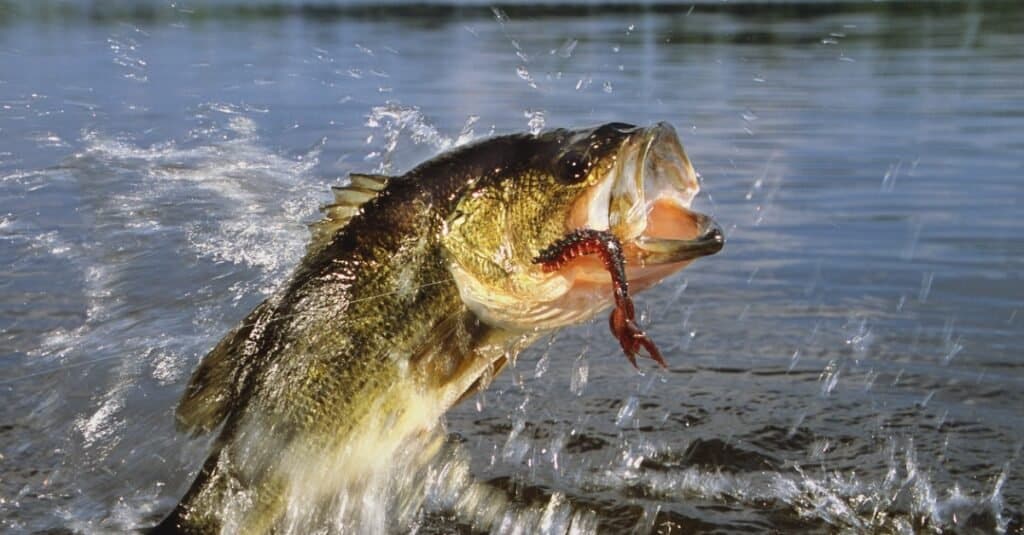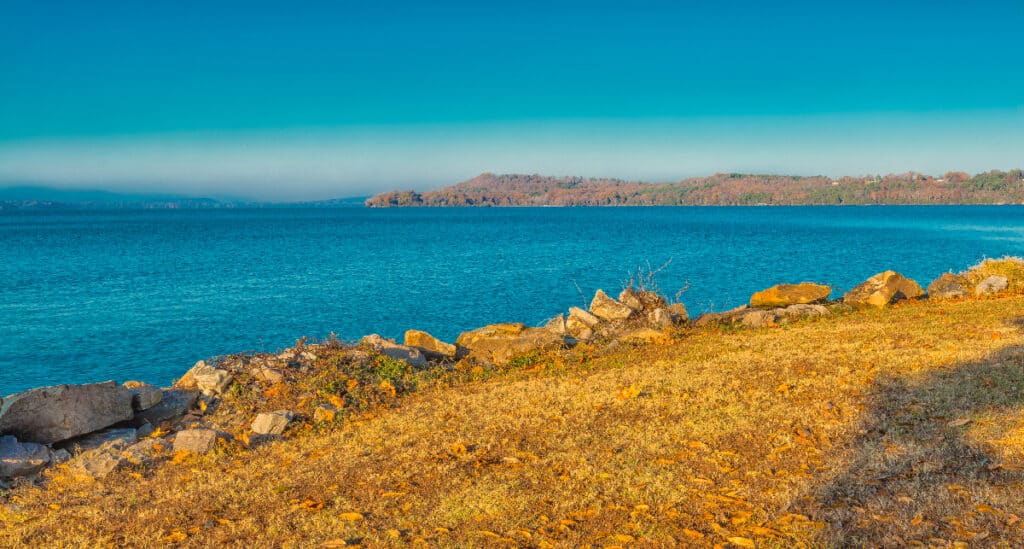The largest largemouth bass ever caught in Arkansas was 16 pounds 4 ounces.
Arkansas is a southern state bordered on the east by the Mississippi River and lives up to its former state motto as the “Land of Opportunity” with an impressive array of outdoor experiences such as the limestone caves of Blanchard Springs Caverns or the Ozark Mountains. Arkansas is perhaps best known for its wilderness, and Mallard Lake is no exception. It was here, in Mississippi County on a 300-acre lake in 1976, that Aaron Mardis caught a massive largemouth bass, setting the state record for the largest ever caught in Arkansas.
How Big Was the Largest Largemouth Bass Ever Caught in Arkansas?
On February 3rd, 1976, Aaron Mardis caught a 16 pound 4 ounce largemouth bass at Mallard Lake, Mississippi County in the Big Lake Wildlife Management Area. This catch was soon certified as the largest largemouth bass ever caught in Arkansas, and all it took was a basic fishing rod and a little patience.
Largemouth bass are some of the most common freshwater fish that anglers attempt to catch. They are typically dark green in color with a white stripe along the underside and a jaw that originates behind the eye. Older largemouth bass are less social than their younger brethren, which tend to gather in schools, especially when hunting for food.
The species originated in the eastern parts of the United States of America and is now sought after all over the country (except Alaska) and worldwide. Bass can grow to varying degrees of length but tend to be larger in the southern areas of the United States due to a confluence of factors such as food supply and water temperature.
Aaron Mardis’ record-setting catch was challenged at Lake Dunn, Cross County, Arkansas on February 28, 2012 when Paul Crowder reeled in a 16 pound 5 ounce largemouth bass. However, the Arkansas Game and Fish Commission later retracted the record and ruled that the catch was illegal since Crowder did not have a fishing license at the time and hadn’t since at least April of 2011.

Bass hunt by opening their large mouths and inhaling their prey
©iStock.com/stammphoto
Where Was Arkansas’ Largest Largemouth Bass Caught?
Aaron Mardis’ record-setting bass was caught in one of the oldest wildlife reserves in the country – Mallard Lake at the Big Lake Wildlife Management Area. President Woodrow Wilson helped create this 11,038-acre expanse via presidential Executive Order in August 1915, and today it is managed by the Arkansas Game and Fish Commission.
Mallard Lake is a man-made lake, created in 1967 via the strategic arranging of levees in the southern marshes of the reserve. The area is known for its boating and fishing and even sports a pier for those trying to catch the many species of fish that make their home in the lake — including bluegill and redder sunfish, crappie, catfish and largemouth bass. After Aaron Mardis caught his 16-plus-pound bass, the popularity of Mallard Lake skyrocketed and today many fishermen and nature enthusiasts flock to the area to enjoy its beautiful marshes, boating, fishing, and wildlife.
Big Lake National Wildlife Refuge is a particularly ideal spot for birdwatching too, as it was initially created to be a natural reserve for Arkansas’ bird population. In 2001 it was even honored by the American Bird Conservancy as a “Globally Important Bird Area.” The Wilderness Preservation System has integrated 2,000 acres of the refuge, and 5,000 acres are currently recognized as National Natural Landmarks.

Big Lake National Wildlife Refuge is an important resource for anglers and birdwatchers alike.
©U.S. Fish and Wildlife Service Headquarters, Public domain, via Wikimedia Commons – License
How Big Are Largemouth Bass, Typically?
We now know the size of Aaron Mardis’ catch, but how big do most largemouth bass typically get?
The average weight can be anywhere from 1 to 5 pounds, and anywhere from 13 to 20 inches in length, usually landing around 16 inches. The environment that largemouth bass live in is the biggest determining factor in their growth — everything from the quality and temperature of the water all the way to the availability of food sources has a part to play.
During its first year of maturation, a largemouth bass will only grow around 4 to 6 inches. By the end of their second year this number increases to 8 to 12 inches, and at three years of age they tend to reach at least 16 inches in length.
Typically the bigger largemouth bass are females, as most males only reach 5 pounds. Largemouth bass live for a maximum of 23 years, but are usually not big enough to interest fishermen until at least three years of age. The biggest largemouth bass on record is 22 pounds, and the longest bass was recorded at 38.2 inches.
These fish are usually found lurking around well-protected areas such as rock clusters, lakeside vegetation, reeds and logs, and even human constructions such as pier pillars and docks. The steadier the water, the more likely a largemouth bass will find it a suitable habitat.
Originally largemouth bass were found to the east of the Rocky Mountains, throughout the lakes and rivers of Texas, and in a few parts of lower Canada and upper Mexico. Their popularity amongst fishermen helped spread their presence across the world — one of the largest largemouth bass ever caught was actually in Japan!
What Is the Average Lifespan of a Typical Largemouth Bass?
The average lifespan of a typical largemouth bass ranges anywhere from a decade to 16 years. In warmer waters these fish tend to live until 10 or 11, but in cold water with less access to abundant food sources they can live up to 16 years.
The location of a largemouth bass has a considerable effect on its lifespan because cooler water conditions slow their aging process while temperate waters accelerate its growth. This is why the biggest largemouth bass are usually found in the southern parts of the United States, while the oldest largemouth bass are found in the northern parts of the United States.
What Are the Best Lakes and Rivers for Largemouth Bass Fishing in Arkansas?
Arkansas has over 90,000 miles of river and more than 600,000 acres of lake spread out across its 53,179 square miles. The state is home to both the Mississippi River and the Arkansas River, which retain a reputation as popular spots for catching various species of catfish, bass, and crappie.
The Mississippi is famous for its catfish in particular, and Arkansas’ largest blue catfish (116 pounds 12 ounces) was even caught on its banks in 2001 by Charles Ashley Jr. It was the world’s largest catfish on record until 2005, when a man in Southeast Asia caught a 646-pound catfish that was 9 feet long.
Lake Dardanelle is a 34,300-acre reservoir on the Arkansas River that proves to be a popular location year-round. It’s not only a great place for boating, camping, golfing and horse riding, but also home to fishing tournaments such as the AFTCO Collegiate Bass Open or the Phoenix Bass Fishing League Super Tournament. Crappie, bream, and largemouth bass are some of the most popular fish at Lake Dardanelle, but you can also find flathead, blue, and channel catfish as well as striped and redear sunfish. The world record for the biggest walleye catch was recorded here in 1982, when Al Nelson caught a 22 pound, 11 ounce fish during a tournament.
Greers Ferry Lake is another great area for fishing, and one of the clearest lakes in the United States! Its 40,499 acres used to be a town called Hidden, but it had to be moved before the completion of the Greers Ferry Dam along the Little Red River. The lake itself boasts a host of activities such as scuba diving, camping, fishing, and even cliff diving. Common fish species at Greers Ferry Lake range from rainbow trout, bluegill, and channel catfish to walleye, white and black crappie, and both large and smallmouth bass.
Table Rock Lake in the Tri-lake area (along with Bull Shoals Lake and Lake Taneycomo) is one of Arkansas’ most famous attractions and is revered as one of the state’s best spots for fishing. With an 800-mile-long shoreline and 43,097 acres of water, Table Rock Lake even stretches in Missouri, though most of it lies within Arkansas state lines. Jet-skiing, wakeboarding, boating, and swimming are all prominent activities at the lake, and its selection of fish is excellent. Often-spotted species include trout, white bass, catfish, and crappie.

Lake Dardanelle is a popular destination for anglers, but it also accommodates boaters, wakeboarders, jet skiers, and swimmers.
©iStock.com/Patrick Jennings
Up Next
- River Monsters: Discover the Biggest Fish in the Mississippi River
- Discover the Largest Largemouth Bass Ever Caught in Florida
- Discover the Largest Sauger Ever Caught in the Mississippi River
The photo featured at the top of this post is © iStock.com/stammphoto
Thank you for reading! Have some feedback for us? Contact the AZ Animals editorial team.






